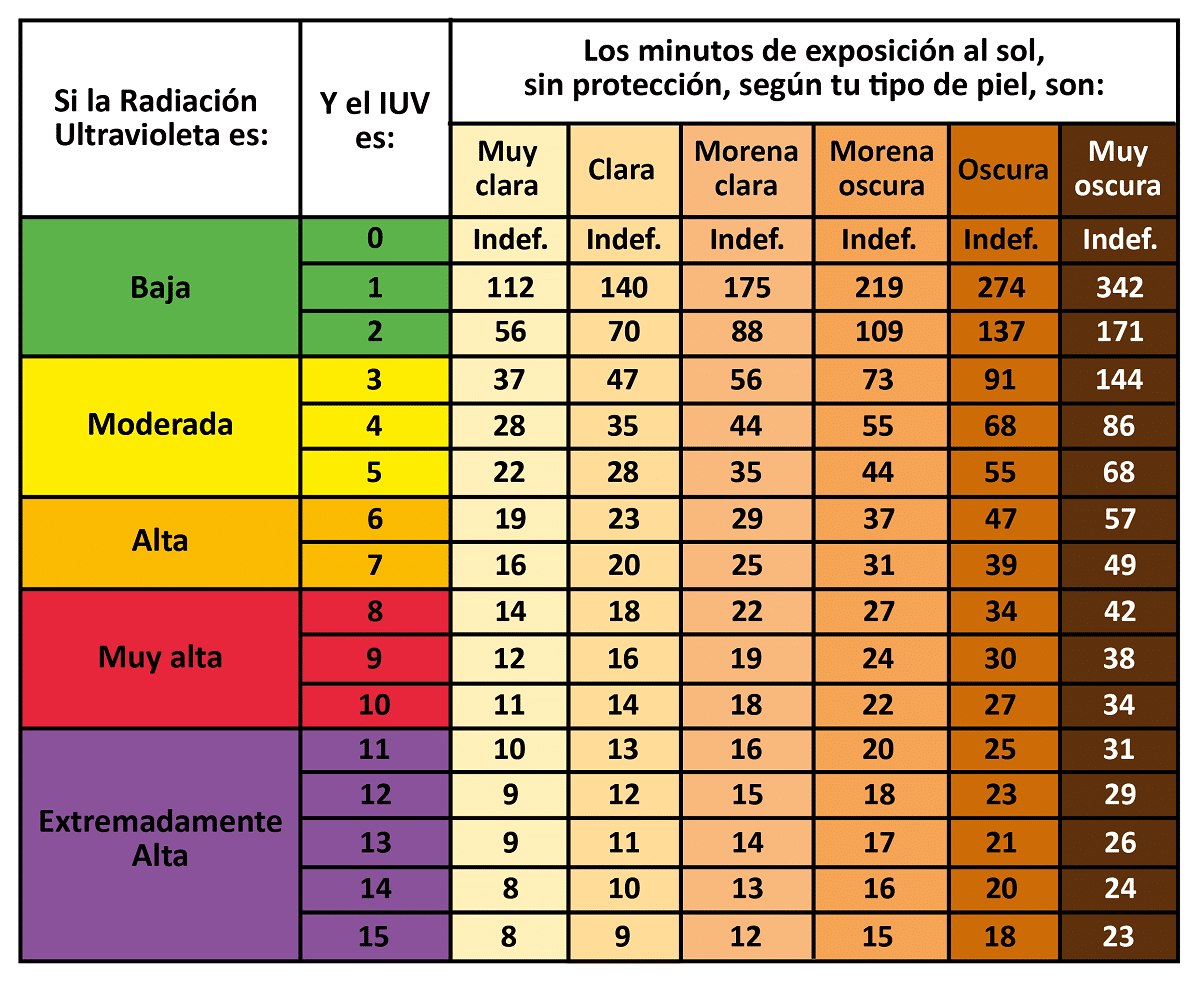
Different amounts of radiation from the sun reach our planet. One of these radiations is ultraviolet. He ultraviolet index It is the measure of the intensity of ultraviolet radiation that is capable of reaching the earth's surface. We know that the sun emits radiation in a wide range of the electromagnetic spectrum. In particular, it emits a significant amount of radiation in the ultraviolet zone. This radiation is of great importance since it is necessary, but also dangerous.
Therefore, we are going to dedicate this article to tell you about all the characteristics and importance of the ultraviolet index.
Key features

We have mentioned that the ultraviolet index is nothing more than a measure of the intensity of ultraviolet radiation that is capable of reaching the earth's surface. All the radiation emitted by the sun is divided into the different parts of the electromagnetic spectrum. Ultraviolet radiation is divided into 3 zones depending on its energy. The most energetic ultraviolet rays are known as UVC and they work at wavelengths ranging from 100-280 nm. The wavelength of UVB rays ranges from 280-315 nm. Finally, UVA rays are the least dangerous, so to speak, and comprise areas of the electromagnetic spectrum ranging from 315-400 nm.
The most harmful part of ultraviolet radiation is UVC radiation. This radiation, fortunately, does not reach the earth's surface as it is absorbed by our atmosphere. In particular, a large part of this radiation is absorbed in the ozone layer. However, UVB rays are absorbed in the atmosphere by 90% approximately. Although UVAs are also absorbed to a lesser extent, a part of them reaches our surface.
We know that the sun's rays are necessary for the development of life as we know it. It must be remembered that photosynthesis in plants takes place thanks to the action of ultraviolet rays and humans need to be exposed to sunlight to synthesize vitamin D in the skin. A deficiency of this vitamin in the body can lead to a deficient mineralization of the bones. Therefore, it is essential to sunbathe every day for at least half an hour. However, if we have an overexposure to the appearance of these ultraviolet rays it can be harmful to health. And it is that ultraviolet radiation can cause damage to the collagen of the skin and therefore increase premature aging.
UV Index Damage

The delta violet index is the one that measures the wavelengths and the quantity and intensity of ultraviolet rays that are capable of reaching the earth's surface. However, ultraviolet radiation can cause DNA damage and mutations. There is numerous evidence from studies that shows that it can significantly increase the risk of skin cancer. Likewise, it can cause serious eye problems such as cataracts. There are different types of skin and some are more vulnerable than others. The sensitivity to ultraviolet radiation of the skin depends on what is known as a phototype. The phototype is in charge of measuring the ability of the skin to absorb solar radiation. That is, the ability of the skin to generate melanin. The violet index must be known well to know the protection that we must apply to the skin for solar radiation according to the sensitivity that we have. Redheaded or blonde people are more sensitive than brunettes.
The so-called ultraviolet index is responsible for measuring the intensity of ultraviolet radiation that reaches the earth's surface at each wavelength weighted with its harmful action on humans. This index was introduced by Environment Canada scientists in 1992. From there, several countries introduced their own indices until the WHO has introduced a standard index for the world.
UV Index Values

The UV index has a theoretical minimum value of 0 and has no maximum value. The standard index is the one that allows us to make various predictions of comparable UVI around the world. The colors that are used to represent the initial vane are green for low UVI values between 0 and 2, yellow for moderate UVI values between 3 and 5, orange with a higher risk between 6 and 7 and red for very high UVI values that are between 8 and 10. Finally, also the purple color is found for extreme UVI values with figures higher than 11.
Depending on the value of the UVI and depending on the skin type of each person, age, etc. Adequate measures must be taken to protect against ultraviolet radiation. The UVI depends on a few factors and can change throughout the year. For example, it depends on the amount of ozone in the atmospheric column, the elevation of the sun, the altitude of the place where we are and the cloudiness present in that instant. It is not the same to be at sea level than at the top of a mountain. The amount of solar radiation that is going to affect our skin is highly variable. The same is true of the ozone layer. The dreaded ozone hole was due to a reduction in the concentration of stratospheric ozone and now a higher incidence of ultraviolet solar radiation on our surface.
Measures to alleviate ultraviolet radiation
We are going to give some of the essential measures to be able to protect ourselves against the action of ultraviolet radiation on our skin:
- Reduce sun exposure during the strongest hours of the day. These are the central hours in which the amount of solar ultraviolet radiation is greatest.
- Walk in the shade in the central hours of the day. Just as we must avoid exposing ourselves to the sun of the central hours, if we do not have another option we must go for the shade.
- Wear protective clothing
- Wear a wide-brimmed hat to protect your eyes, face, and neck.
- Protect our eyes with sunglasses
- Use a broad spectrum sun protection cream.
- Avoid tanning beds
I hope that with this information you can learn more about the ultraviolet index and its importance.